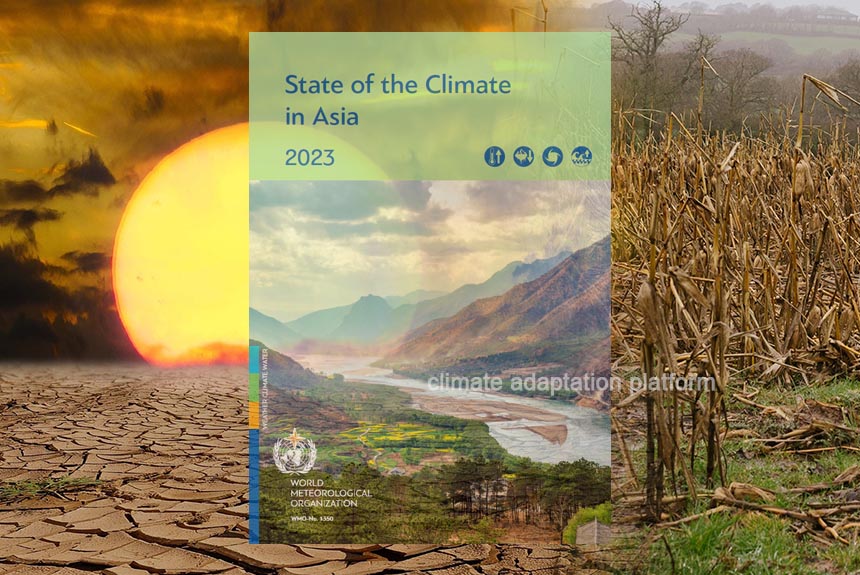In April and May this year, south and southeast Asia were hit by brutal heatwave conditions, which have already claimed dozens of lives, closed schools, destroyed crops, and affected produce. Experts labelled the ongoing heatwave in the region as the “most extreme event” in climate history (Zargar, 2024).
The Guardian reports that unprecedented temperatures in the Philippines reached up to 43°C and in Bangladesh registered between 2 to 8 C hotter than 33.2C for April, causing numerous schools to close due to the unbearable heat. CBS News reports that the relentless heat in the Philippines has forced thousands of schools to close while other parts of the country suffered droughts.
Since the start of 2024, Thailand has seen at least 30 deaths due to heatstroke. The extreme heat in the country has also caused durian fruit to burst on trees, destroyed rice crops, and caused ducks’ eggs to shrink, affecting their livelihood. Vietnam and India have also seen temperatures of 43C.
Dr Roxy Mathew Koll, a climate scientist at the Indian Institute of Tropical Meteorology, said: “The frequency, intensity, duration and the area covered by these heatwaves are increasing over time. We are on a rollercoaster in terms of temperature, which will not come down any time soon. It’s going to be worse, which means we need to be prepared.” Koll is calling on governments to adapt by developing policies to decide, for example, when schools should be shut or how to protect workers (Ratcliffe, 2024).
As South and Southeast Asia swelters in a suffocating heatwave, the World Meteorological Organization (WMO) released the State of the Climate in Asia 2023 report on 23 April 2024. The report says that Asia has warmed faster than the global average since 1960.
The region also remained the world’s most disaster-hit region from weather, climate, and water-related hazards in 2023, with a total of 79 disasters associated with hydro-meteorological hazard events, of which 80% were related to flood and storm events, with more than 2,000 fatalities and nine million people directly affected. The region also faces growing health risks from extreme heat, but heat-related mortality is not frequently reported.
The report highlights the accelerating rate of crucial climate change indicators such as surface temperature, glacier retreat and sea level rise.
Temperatures
The annual mean near-surface temperature over Asia in 2023 was the second highest on record, 0.91 °C above the 1991–2020 average and 1.87 °C above the 1961–1990 average. High average temperatures were recorded, mainly from western Siberia to central Asia and from eastern China to Japan. Japan and Kazakhstan each had record-warm years.
Precipitation
In 2023, precipitation was below normal in large parts of Turkmenistan, Uzbekistan, Kazakhstan, Afghanistan, Pakistan, the Himalayas (in India and Bangladesh), the Arakan Mountains in Myanmar, and the lower course of the Mekong River. Southwest China suffered from a drought, with below-normal precipitation levels nearly every month of 2023, and the rains associated with the Indian Summer Monsoon were below average.
Cryosphere
In the last several decades, most of the glaciers in the High-Mountain region have been considered the Earth’s third pole because the amount of glaciers and snow outside the Earth’s polar ice sheets has seen a rapid retreat. The Tibetan Plateau, around 100,000 square kilometres, also shows continued mass loss due to record-breaking temperatures and dry conditions in the East Himalayas and most of the Tien Shan.
Sea surface temperatures and ocean heat
In 2023, the global average sea surface temperature (SST) was off the charts, including Asia. The worst affected was the Northwest Pacific Ocean, where the area-averaged SST anomalies were the warmest on record. Warming of the upper ocean (0 m–700 m) is extreme in the northeastern Arabian Sea, the Philippine Sea, and the seas east of Japan, more than three times faster than the global average.
The report emphasises Asia’s need for a more significant disaster risk reduction intervention. Over fifty years of data, the region recorded 3,612 disasters attributed to weather, climate, and water extremes, with 984,263 deaths and USD 1.4 trillion in economic losses.
The report notes, “Disaster risk reduction in Asia is facing an alarming gap in climate projections and tailored products that are needed to inform long-term interventions such as adaptation to and mitigation of climate change and its impacts. Currently, less than 50% of Members are providing tailored products, indicating a significant inadequacy in view of the region’s high vulnerability to climate-related disasters.”
Sources:
Ratcliffe, R. (2024, May 4). ‘Inside an oven’: sweltering heat ravages crops and takes lives in southeast Asia. The Guardian. Retrieved from https://www.theguardian.com/environment/article/2024/may/04/inside-an-oven-how-life-in-south-east-asia-is-a-struggle-amid-sweltering-heat
Zargar, A. (2024, May 2). Summer heat hits Asia early, killing dozens as one expert calls it the “most extreme event” in climate history. CBS News. Retrieved from https://www.cbsnews.com/news/heat-wave-asia-2024-deaths-india-severe-weather-climate-change/
State of the Climate in Asia 2023. World Meteorological Organization. Retrieved from https://library.wmo.int/viewer/68890/download?file=1350_State-of-the-Climate-in-Asia-2023.pdf&type=pdf&navigator=1
State of the Climate in Asia 2023. (2024, April 23). World Meteorological Organization. Retrieved from https://wmo.int/publication-series/state-of-climate-asia-2023#:~:text=Asia%20remained%20the%20world’s%20most,of%20heatwaves%20became%20more%20severe.



Leave a Reply